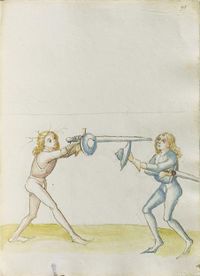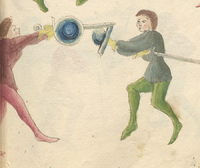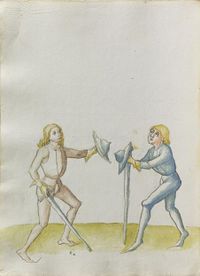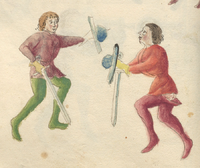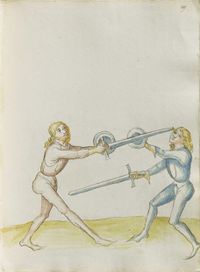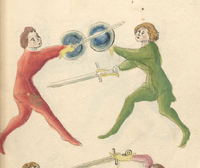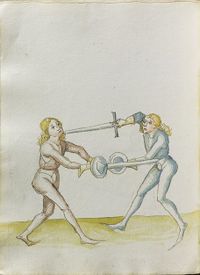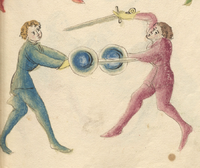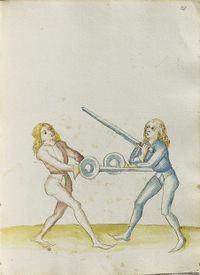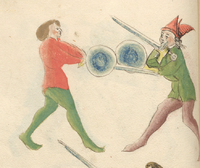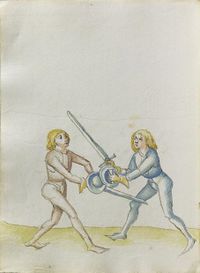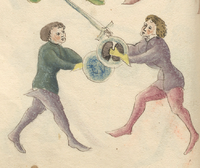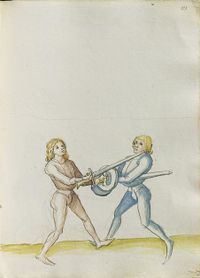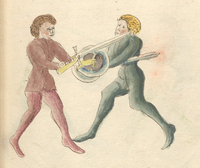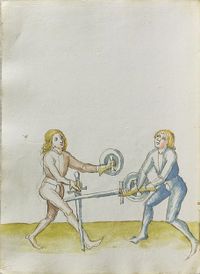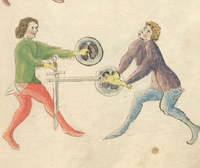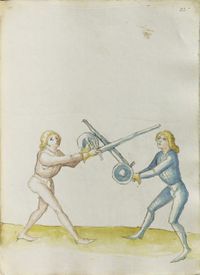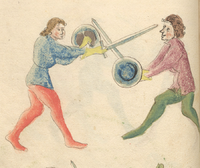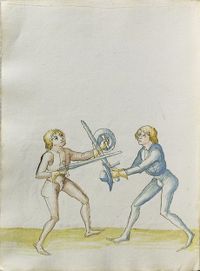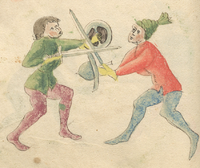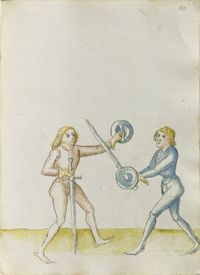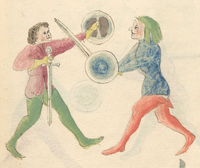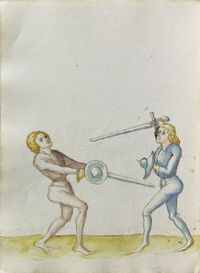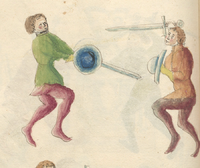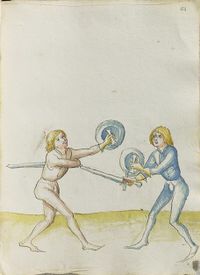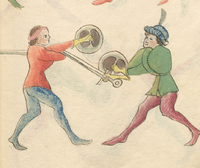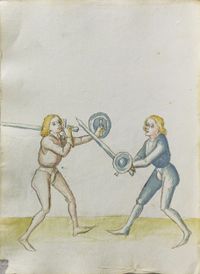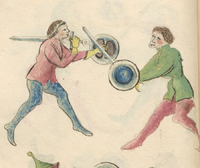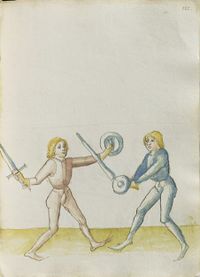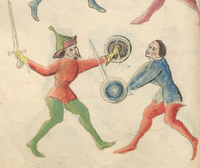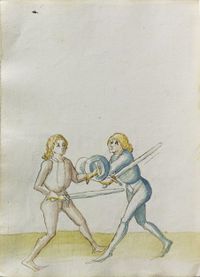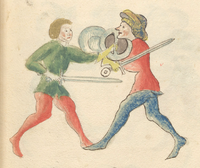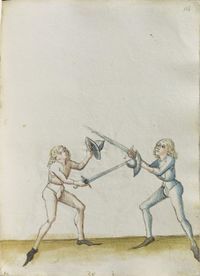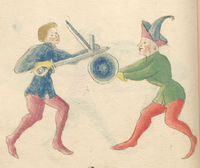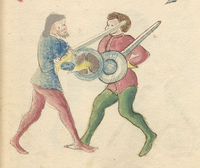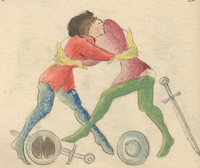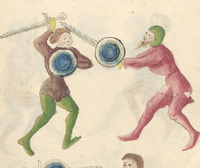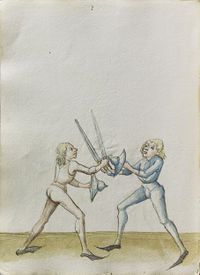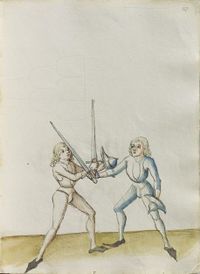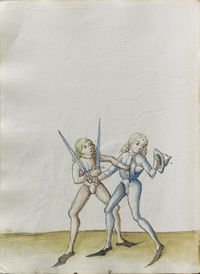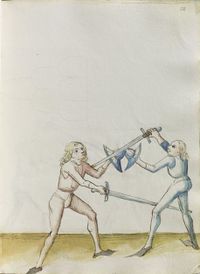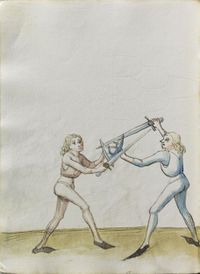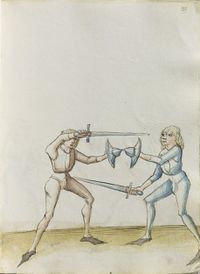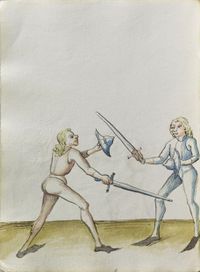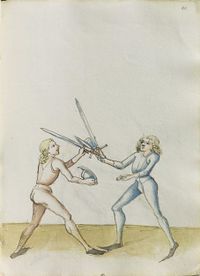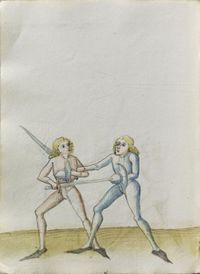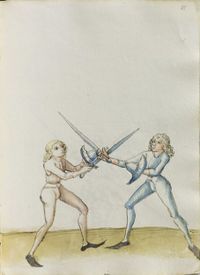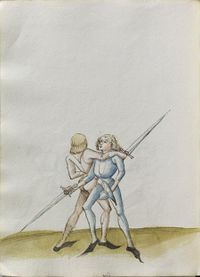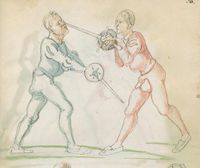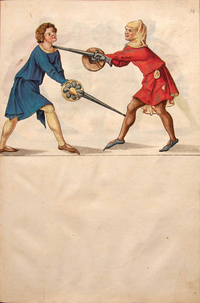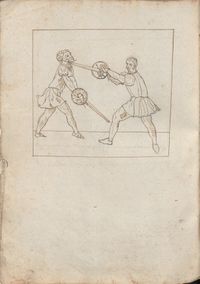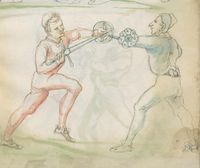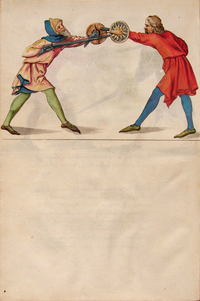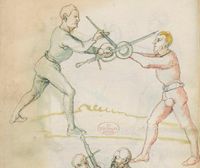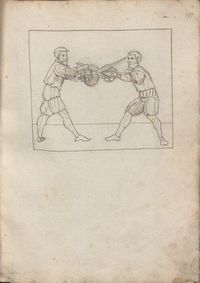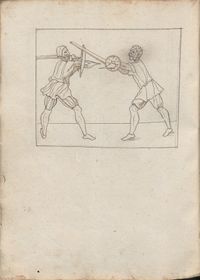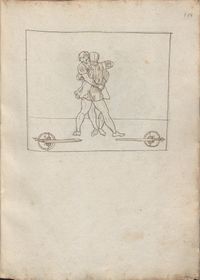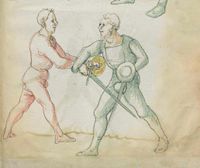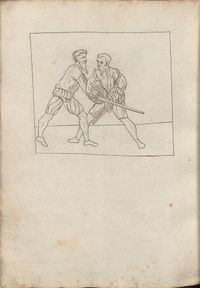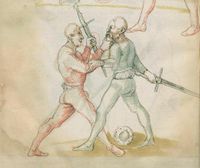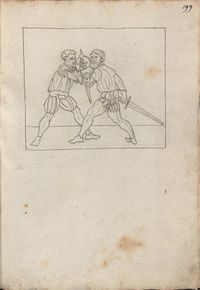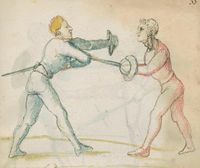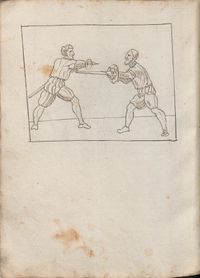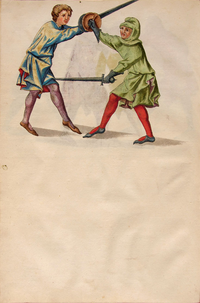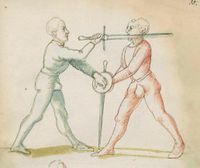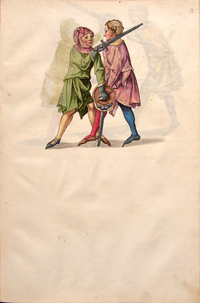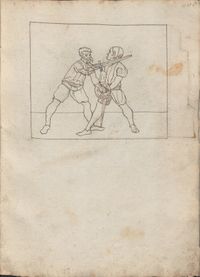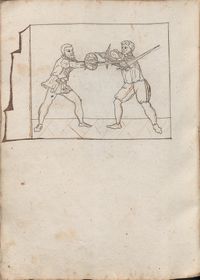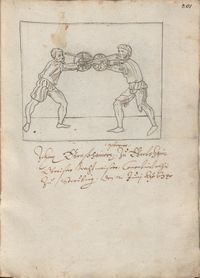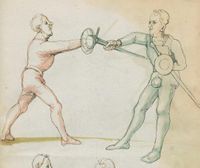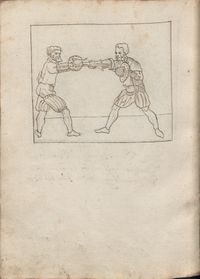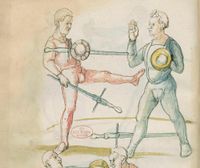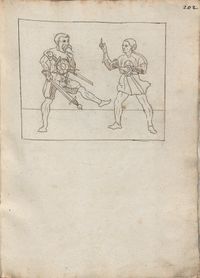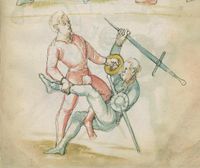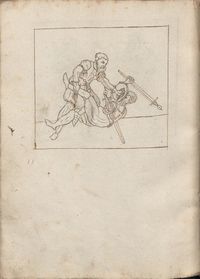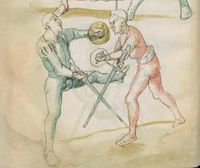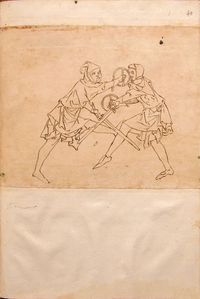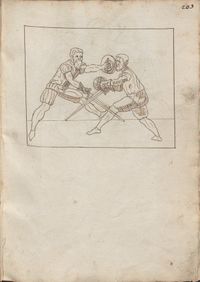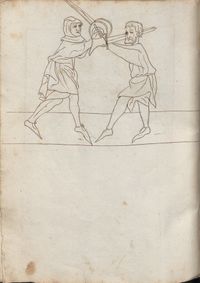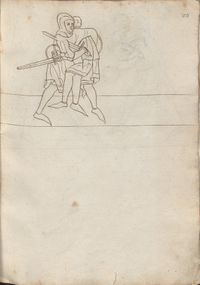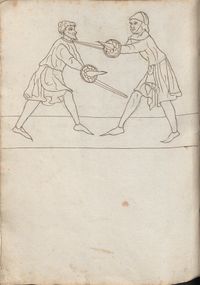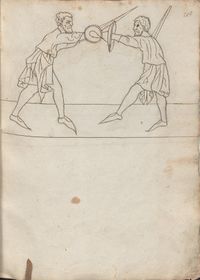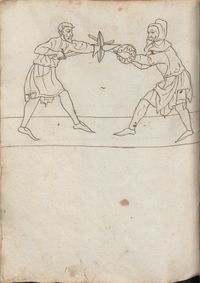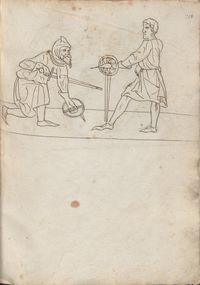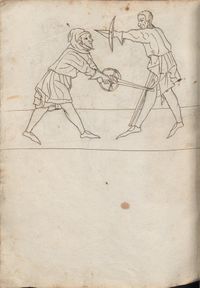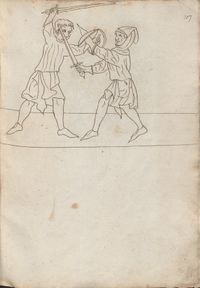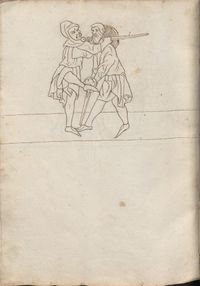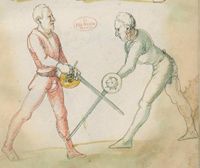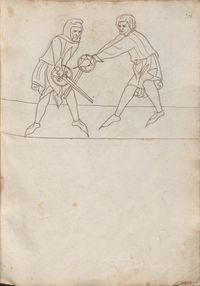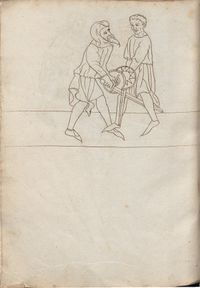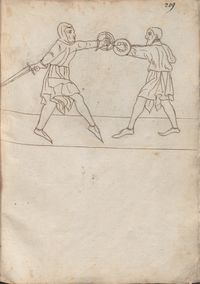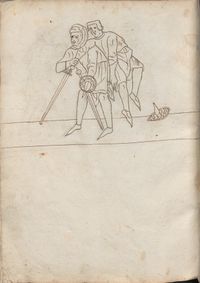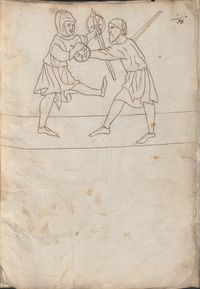|
|
You are not currently logged in. Are you accessing the unsecure (http) portal? Click here to switch to the secure portal. |
Difference between revisions of "Anonymous sword and buckler images"
| Line 1: | Line 1: | ||
These uncaptioned images generally appear across multiple manuscripts, but their origin and relationship are entirely unknown. | These uncaptioned images generally appear across multiple manuscripts, but their origin and relationship are entirely unknown. | ||
| + | |||
| + | The first group, found in the [[Cluny Fechtbuch (Cl. 23842)|Cl. 23842]] and the [[Eyb Kriegsbuch (MS B.26)|MS B.26]]; their presence in the Cluny may indicate that they were intended to illustrate one or more prior German fencing treatises (such as that of [[Andre Lignitzer]]). | ||
The second group, found in the [[Berlin Sketchbook (Libr.Pict.A.83)|Libr.Pict.A.83]], [[Jörg Breu Draftbook (Cod.I.6.2º.4)|Cod.I.6.2º.4]], and [[Maister Liechtenawers Kunstbuech (Cgm 3712)|Cgm 3712]], are believed to have been part of the tradition that produced the [[Walpurgis Fechtbuch (MS I.33)|MS I.33]], and along with the writings of [[Paulus Kal]] formed the basis of [[Paulus Hector Mair]]'s treatment of the weapon combination. | The second group, found in the [[Berlin Sketchbook (Libr.Pict.A.83)|Libr.Pict.A.83]], [[Jörg Breu Draftbook (Cod.I.6.2º.4)|Cod.I.6.2º.4]], and [[Maister Liechtenawers Kunstbuech (Cgm 3712)|Cgm 3712]], are believed to have been part of the tradition that produced the [[Walpurgis Fechtbuch (MS I.33)|MS I.33]], and along with the writings of [[Paulus Kal]] formed the basis of [[Paulus Hector Mair]]'s treatment of the weapon combination. | ||
| Line 81: | Line 83: | ||
| [[File:MS CL23842 126r.jpg|200px|center]] | | [[File:MS CL23842 126r.jpg|200px|center]] | ||
| style="vertical-align:bottom;" | [[File:MS B.26 54v-a.png|200px|center]] | | style="vertical-align:bottom;" | [[File:MS B.26 54v-a.png|200px|center]] | ||
| + | |||
| + | |- | ||
| + | | | ||
| + | | [[File:MS B.26 54r-b.png|200px|center]] | ||
| + | |||
| + | |- | ||
| + | | | ||
| + | | [[File:MS B.26 54v-b.png|200px|center]] | ||
| + | |||
| + | |- | ||
| + | | | ||
| + | | [[File:MS B.26 59r-a.png|200px|center]] | ||
|- | |- | ||
| Line 125: | Line 139: | ||
| [[File:MS CL23842 131v.jpg|200px|center]] | | [[File:MS CL23842 131v.jpg|200px|center]] | ||
| | | | ||
| − | |||
| − | |||
| − | |||
| − | |||
| − | |||
| − | |||
| − | |||
| − | |||
| − | |||
| − | |||
| − | |||
| − | |||
|} | |} | ||
Revision as of 21:36, 16 July 2017
These uncaptioned images generally appear across multiple manuscripts, but their origin and relationship are entirely unknown.
The first group, found in the Cl. 23842 and the MS B.26; their presence in the Cluny may indicate that they were intended to illustrate one or more prior German fencing treatises (such as that of Andre Lignitzer).
The second group, found in the Libr.Pict.A.83, Cod.I.6.2º.4, and Cgm 3712, are believed to have been part of the tradition that produced the MS I.33, and along with the writings of Paulus Kal formed the basis of Paulus Hector Mair's treatment of the weapon combination.
Images
Paris Version (after 1495) |
Erlangen Version (1500) |
|---|---|
Berlin Version (ca. 1512) |
Augsburg Version (1545) |
Munich Version (1556) |
|---|---|---|
For further information, including transcription and translation notes, see the discussion page.

